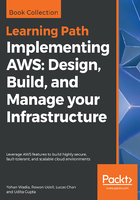
上QQ阅读APP看书,第一时间看更新
CloudWatch
CloudWatch has undergone a lot of new and exciting changes and feature additions compared to what it originally provided as a service a few years back. Here's a quick look at some of its latest announcements:
- CloudWatch events: One of the most anticipated and useful features added to CloudWatch is CloudWatch events! Events are a way for you to respond to changes in your AWS environment in near real time. This is made possible with the use of event rules that you need to configure, along with a corresponding set of actionable steps that must be performed when that particular event is triggered. For example, designing a simple back-up or clean-up script to be invoked when an instance is powered off at the end of the day, and so on. You can, alternatively, schedule your event rules to be triggered at a particular interval of time during the day, week, month, or even year! Now that's really awesome!
- High-resolution custom metrics: We have all felt the need to monitor our applications and resources running on AWS at near real time, however, with the least amount of configurable monitoring interval set at 10 seconds, this was always going to be a challenge. But not now! With the introduction of the high-resolution custom metrics, you can now monitor your applications down to a 1-second resolution! The best part of all this is that there is no special difference between the configuration or use of a standard alarm and that of a high resolution one. Both alarms can perform the exact same functions, however, the latter is much faster than the other.
- CloudWatch dashboard widgets: A lot of users have had trouble adopting CloudWatch as their centralized monitoring solution due to its inability to create custom dashboards. But all that has now changed as CloudWatch today supports the creation of highly-customizable dashboards based on your application's needs. It also supports out-of-the box widgets in the form of the number widget, which provides a view of the latest data point of the monitored metric, such as the number of EC2 instances being monitored, or the stacked graph, which provides a handy visualization of individual metrics and their impact in totality.